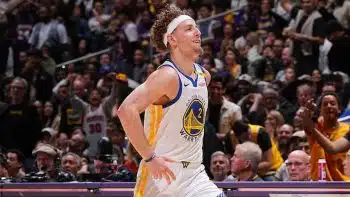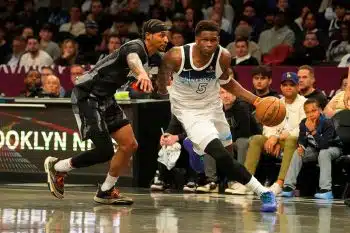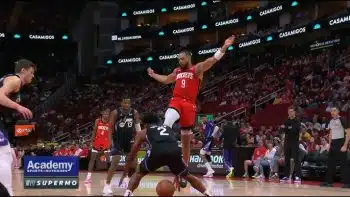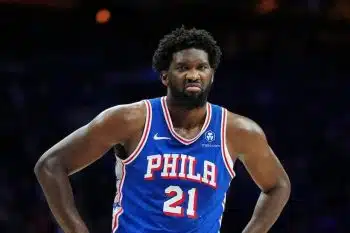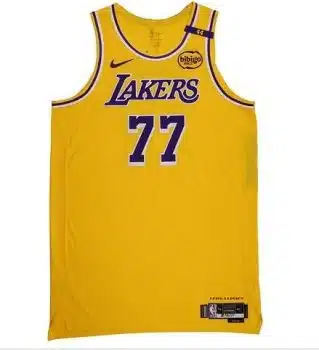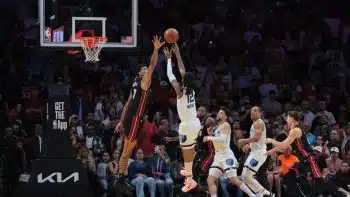NBA
Fixing the Denver Nuggets
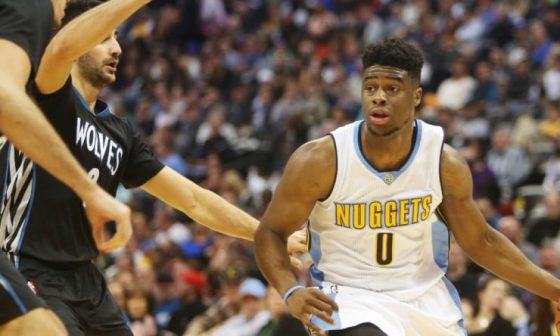
As teams like the Philadelphia 76ers have pushed the boundaries of NBA team building under the current rules, something of a taboo lexicon has become prevalent in many circles. Terms like “process” have been used so often that they’re punchlines at this point. Everyone has their two cents on when a particular non-title contender should “rebuild,” whether or not they bother to qualify such an opinion with any specifics. And god forbid anyone utter that veritable cuss word, “tanking” – there might be children present.
The Denver Nuggets are a solid microcosm for the way our inherent need to label things can cloud what’s really a simpler picture. The observer intent on pigeonholing the Nuggets into a specific category along the team construction spectrum will find contradictory indicators almost immediately. Denver has many of the characteristics of a “rebuilding” team, set against several elements more commonly associated with teams further along in the process.
The Nuggets’ on-court product for the 2015-16 season saw them swap out these various masks regularly. A 6-5 start, with two wins over presumed (at the time) contenders, the Houston Rockets and the New Orleans Pelicans, got them out of the gate more quickly than most had expected – only for eight straight losses from there during a brutal November stretch to bring them back down to earth. As the year wore on, they traded impressive wins that signaled progress beyond their collective age (two over the Toronto Raptors, a February victory over the L.A. Clippers and their signature win of the year over the Golden State Warriors at home in January), with ugly losses that reminded us how far away they still are (a combined eight defeats to the L.A Lakers, Sacramento Kings, Brooklyn Nets and Orlando Magic).
None of this is necessarily bad, even the tougher losses, which might inherently seem so. They all fall under the “learning experiences” tab for now, with a key reality driving a very positive outlook in Denver: None of it mortgaged the future in any way.
Far from boxing the Nuggets in with a particular group or identity, this year’s events and those preceding them have left them as among the most flexible up-and-coming groups in the league. They have six legitimate young prospects, including guys in Nikola Jokic and Emmanuel Mudiay whose ceilings are still very high. They hold all their own first-round picks, the right to swap with the Knicks in the 2016 first-round, two mid-teen 2016 picks courtesy of Houston and the Portland Trail Blazers and a 2017 first-round pick from the Memphis Grizzlies (protected top-five, a very unlikely landing spot). And, of course, they hold the rights to three veteran players with varying levels of value – be it to Denver or another team.
Here we take a look at a few of their most pressing topics entering the summer:
Vet the Vets
It’s strange to think of Danilo Gallinari, Wilson Chandler and Kenneth Faried as “veterans” when the oldest among them is Chandler at 28, but in a relative sense it’s very true in Denver.
Faried is still in his physical prime at 26, and his age track really isn’t so far removed from the young guys. The issue with him is one of fit and, quite honestly, quality as a modern NBA player given the size and length of his contract. He isn’t exactly breaking the bank, but three more years at a starter-level salary is tough enough for a guy who really doesn’t fit that label on the court – and that’s before one considers that each of Jokic, Jusuf Nurkic and Joffrey Lauvergne is potentially ready to come into their own. Jokic and Nurkic are both 21, and Jokic is already a more valuable NBA player than Faried.
Nuggets GM Tim Connelly doesn’t have to do anything with Faried. All three young guys are probably better as centers, and Jokic in particular won’t be sliding down to power forward any time soon. If all parties are comfortable with a situation where playing time isn’t necessarily in line with salary earned, keeping Faried and playing the best combinations is absolutely a tenable option. But as a big who can’t shoot or defend the rim, there’s a real chance Faried is near the bottom of that totem pole before long. That situation could get sticky in a hurry.
Similar cases could be made for Gallinari and Chandler to some degree, but are made tougher by age and significant health concerns in both cases. Chandler will be 29 before he plays another NBA game, and missed the entirety of the 2015-16 season after hip surgery – his third year in the last five where he played 43 games or fewer. Gallinari is one of the more well-known injury-riddled cases in the league within the last half decade.
Both can still have real value if healthy, Gallinari in particular within a Nuggets context if they choose to move Faried. Danilo should spend almost all his time at power forward in the 2016 NBA, and a Jokic-Gallinari frontcourt is a tantalizing prospect even if they’re far apart in age. Chandler can provide a solid two-way game at the small forward spot, likely the weakest in Denver’s young stockpile.
With so many factors at play, the “right” course of action is really tough to discern. The Nuggets aren’t as concerned as most developing teams with staying in the high lottery, what with so many young chips already in place and more on the way if they desire. The experience and know-how these older guys bring to the table could be valuable to the young bucks, though predicting those dynamics with any accuracy is tough. The size of their stockpile is important when considering the potential return on a trade involving one of the vets – too many more young pieces coming back would quickly bring them to a saturation point, something the Nuggets will already be approaching if they make all three of their first-round picks this year.
There aren’t too many truly wrong answers here with so much flexibility, but how Connelly chooses to maximize the pieces and which direction he moves in will be telling.
Parsing the Youngsters
The Nuggets need to continue the already-active process of evaluating their young core, even as they simultaneously address their larger salary slots and the interplay between the two sets of players.
The frontcourt is most crowded and most interesting, especially while Faried and Gallinari remain in the fold. Jokic quickly separated himself in his rookie season, stretching the floor (33 percent from deep is more than fine for a rookie at his position) and showcasing ball skills rare for anyone his size, much less a 21-year-old. Jokic became the first rookie center since 1974-75 to log over 1,000 minutes and assist on at least 18 percent of teammate baskets while on the floor, per basketball-reference.com – and just the third player in league history to do so, joining Alvan Adams and the great Bill Walton.
Jokic already has all the basics you hope for from a passing big. He uses his length well to view and create angles, and has a good sense for where guys like the ball (don’t throw a bounce pass to a seven-footer rolling for a dunk, that sort of thing). He’s decisive, and rarely hesitates or gets tunnel vision. But when you see a kid this young pulling out second-level stuff like a look-off thread pass, on the move and in traffic against a top defense, you have to double-take for a moment.
Mudiay was the belle of Denver’s 2015 draft, but a mostly forgotten 2014 second-rounder might already be their top overall prospect. Jokic has enough lateral mobility that he shouldn’t flounder defensively against top pick-and-roll teams, and if his three-point shooting ever ticks up into the high 30s (not unlikely at all) he could be among the most dangerous seven-footers in the league on offense. Continued development at this rate will make adding pieces around him very, very easy. It seems hard to imagine him going anywhere for anything but a Godfather offer.
Nurkic and Lauvergne are tougher to peg. Both have bits of injury concern early in their careers, but both also have plenty of talent. The 2016-17 season will be big for Nurkic, who missed most of this past year and was never quite right physically even when he returned. Whether he can pair with Jokic, something the Nuggets started testing out down the stretch this year, could impact his playing time significantly.
Lauvergne made a leap in his sophomore season, but is an iffier shooter than his reputation suggests and still needs lots of work around the margins. Crazier things have happened than all three sticking around long term, but it feels like there will be at least one odd man out here before it’s all said and done.
The backcourt situation is more straightforward, at least for now. Mudiay had ups and downs in his rookie year, and still boasts plenty of potential as a two-way point guard even if he seems a risky bet to ever become a star-level player. Denver’s offense improved while Mudiay was on the court as the year went on, and while he’ll need significant refinements to several parts of his game, the physical tools are there.
Sophomore Gary Harris led the team in minutes on the season, and is entrenched as the starting shooting guard moving forward. He made a big leap to over 35 percent from three-point range after a disastrous rookie season from distance, and became a much more useful playmaker. He has a long way to go to even reach average as a defender, though, and probably isn’t anything more than a solid supplementary piece offensively. Sixth man Will Barton provided flashes of excitement, but is also already 25 and likely won’t develop much more than what we’ve seen.
Figuring out who fits where is the next big step for Connelly and his team, and accordingly managing the roster around their decisions.
Draft Picks and Timetables
We mentioned over-saturation of draft picks above, and while such a scenario could certainly qualify as a “good problem,” it will still need addressing if the Nuggets keep all their picks over the next few years. Denver has the roster slots to add a few more guys, but will eventually reach a decision point with all of these young pieces – a fate division rival Utah may navigate a year or two before the Nuggets do. There’s only so much money, so many roster spots and so much playing time.
One outlet here is stashing at least a pick or two, something the Nuggets already did with Jokic and Lauvergne for brief periods. A guy overseas won’t count against their cap or roster limits, and could be brought over only if he deserves a spot over a current piece.
Connelly could also look to move some of those picks, but for what? Most teams in Denver’s position, with their best talent a few years away, would be looking to add first-round picks – things are backward here to a large degree. The picks in question aren’t of the blue chip variety that might yield a similar high-ceiling player in the right deal. Would adding a few mid-tier guys in their mid-20s (if you could even find such players available) do much for the bottom line, either now or a couple years from now? It’s unlikely.
Another move floated in some circles is the equivalent of Connelly’s “all-in” button: A big trade for an established player who speeds up the Nuggets’ timeline.
Denver has the resources to pull off such a deal, and might even have the youth and draft capital to hedge against the most negative outcomes of such an aggressive move (mainly the one where they trade for a star, don’t succeed, and said star leaves at his next available opportunity). They’re the only team outside Boston who can offer the triumvirate: A war chest of picks, current NBA rotation players on fair market deals and at least one or two promising young guys already in the league.
Say Kevin Love becomes available this summer, and the Celtics continue to drive too hard of a bargain – what’s stopping Denver from throwing their hat in the ring? It’s a rough pass, but couldn’t some combination of Gallinari/Chandler, Barton, one of the young bigs and a pick or two at least get the conversation started? The Nuggets made significant inquiries on Love while he was still in Minnesota, something Basketball Insiders’ Alex Kennedy reported last year, and remain potentially interested in adding star power at the top of their depth chart.
This sort of thing is obviously unlikely and would be a big risk, but GMs in Connelly’s position don’t win NBA titles by acting conservatively. A guy like Love (or, say, DeMarcus Cousins – just two examples) isn’t so far ahead of the rest of the core age-wise to make this sort of move patently ridiculous, especially if one or two of the youngest are involved in the return package. If they could do it without sacrificing Jokic or Mudiay – maybe tough in Love’s case, but he’s just one possibility – those two plus their draft stockpile would serve as solid insurance if the new star bolts town after his contract is up.
The biggest risk might not even be their target leaving down the line, but rather the move simply not working well enough. Denver was fun at various points this year, but adding Kevin Love and subtracting a couple previous pieces isn’t creating an overnight title contender here. The Nuggets would have to be confident they could supplement things with at least one impactful summer signing (they have plenty of room under the cap) and some major development from the younger guys. They’d have to do all that while mitigating the risk that a guy like Mudiay or Jokic is harmed in the long run by such a diversion from the normal process of development.
Assuming no swing for the fences, the summer is wide open. The Nuggets could open up over $30 million in cap space without batting an eye, enough for a max deal or multiple solid pieces if there’s mutual interest. Connelly should get a second cell phone for draft night, where the Nuggets have the flexibility to poke their noses around into all sorts of potential fun. They should target guys who can complement Jokic and Mudiay’s development where possible, and the goal barring a huge win-now move should be to take a solid step forward without sacrificing much of this flexibility a year down the road.
The Nuggets are straddling the rebuilding fence, but both feet are somehow still on firm ground. They’re in a hugely advantageous position as a franchise, with the ability to pivot in any direction should a clear path emerge.
